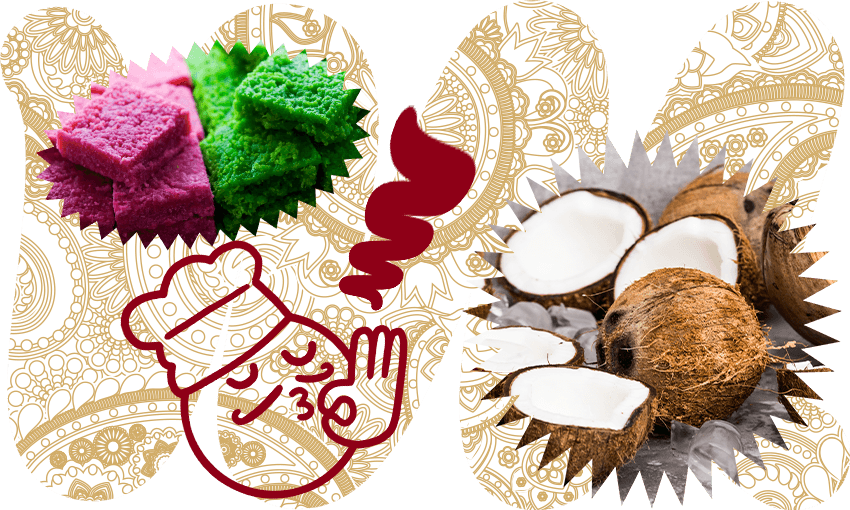Summer read: For Indian-New Zealander Sunita Patel, the taste of coconut evokes memories of childhood, travel and blessings big and small.
First published: April 18, 2022
One of my earliest memories is of a coconut, thrown from the window of a train. In India, train journeys are a mixed bag, sometimes stuffed shoulder to shoulder, hectic between commuting stops, sometimes slow, with an almost festive atmosphere on long haul journeys. Beggars wander up and down the aisles, barefoot and resigned; pedlars too, squatting to cut and season a guava with chilli and salt, or to portion out some other snack when they find a willing buyer. And as the trains cross over bridges, rattling in their rhythmic, rickety way, coconuts and crumpled rupees are hurled from the windows into the churning waters below – an offering from Hindu travellers seeking to ensure a safe journey.
I suppose it’s no surprise a sight like that stuck in the mind of a child who grew up in New Zealand, but it is one of those underlying memories that I rarely turn my mind to. So much so that it only occurred to me some 30-something years later to ask my mum what the deal was with those coconuts. I was thinking of them on a recent morning in Auckland when my grandmother passed away. Within hours, my aunt arrived carrying a bag of coconuts.
During the funeral ceremony, prayers were said and items were placed around the body to smooth her passage from this life and her arrival into the next. Four coconuts were also placed beside each hand and each foot. A few days later it occurred to me that the priest had explained most of the symbolic items used in the ceremony, but not the coconuts. My confusion seemed particularly ironic to me, given I was so often called a coconut when I was growing up: brown on the outside, white on the inside, not very Indian in anything but looks.
Coconuts are generally used in Hinduism as an offering made to the Gods when seeking a blessing. They were brought in as a substitute for human or animal sacrifices that were historically common but ultimately considered distasteful. Thank goodness for that. But in funerals more specifically, the four coconuts symbolise the ambassadors of Yama (the God of the dead) who come to carry the dead. Pallbearers then. Such a versatile fruit. (Or nut, or seed, or drupe – let’s not get into that).
We don’t grow coconuts in New Zealand, but they are a real staple for Asian and Pacific communities, which made up 23% of our population at the last census. The old-school processed forms (chipped, desiccated, and creamed) are a mainstay of cultural icons like the Edmonds cookbook, but the old fella has also undergone a reinvention as a health food in recent times, what with coconut water, coconut sugar and coconut oil being all the rage. And of course, to a much smaller extent, it remains indispensable for ceremonial uses in pockets of our society.
On those summer trips, when my sisters and I were young, I recall my great uncle felling coconuts from the palms in my grandmother’s yard in Gujarat, near the western coast of India. Someone would yell for the kids to get back and then the enormous, smooth, green-yellow bowling balls would fall to the ground with a deep thud. Dada would descend and sit with a machete, hacking into the fibrous outer layers, levering and tearing them from the inner shells. He was left with the smaller, deep brown, hard, hairy shell that looks much like a shrivelled head with three round holes in it.
Two holes are typically stoppered up pretty good, but one is softer and can be pierced to access the delights of the much-coveted coconut water. Back before that stuff came in cartons, we would push through the hole and then turn the coconut on its head, carefully dribbling the cloudy water into a glass before fishing out the shards of brown shell (it’s like pushing a broken cork into a wine bottle – it does the job, but it’s messy). The only thing to do then is to break it open. If you get a young coconut, the flesh can be soft, succulent and slippery. If mature, the hope is to find a thick, dense layer of white flesh with a subtle sweet flavour and pleasing snap when you bite into it.
Historically, the majority of the fresh coconuts consumed in New Zealand were imported from Tonga. They are said to be bigger in size on average than those grown elsewhere, with thicker flesh, although we also get them from a wide variety of places including Thailand, the Philippines and Fiji. India doesn’t really figure in those stats in any significant way. I wondered aloud about this to a friend of mine recently, who exclaimed that there weren’t any coconuts in India, were there? In fact, they are widespread in large swathes of the country, although much less so in the colder but more traditionally tourist-trodden north.
This all led me to wonder whether the Tongan coconut has continued to grace our shores in the aftermath of the eruption and tsunami on theirs. Drought conditions in Tonga had already reduced coconut exports by 80% between 2014 and 2016, and this year there have reportedly been concerns that crops which were fortunate enough to survive the surging waters might yet be taken down by the longer-term impact of volcanic ash. Fresh coconuts, particularly those from Tonga and Fiji, have always been a familiar sight on the sprawling tables at the markets at the Avondale Racecourse, as they were at the weekly Otara Markets (may it rise again unscathed in the post-Covid era).
On a recent early autumn Sunday morning the Avondale Markets were a shadow of their former glory. It’s hard to know whether it’s Covid restrictions or the impending loss of the racecourse site that’s done it. Probably a mixture of both. There is only an echo of the tight throng and hustle bustle of yesteryear, but while the tables and stalls are spread thinner, there is no lack of gleaming Asian greens, fragrant herbs and hulking piles of fruit. Nestled amongst this bounty, I found two rather jovial Sikh men in narrow orange turbans, with long wispy beards and even wider smiles, purveying a pile of Tongan coconuts – heavy, generously round, sloshing bountifully with the promise of the many layered delights inside. A real live blessing.

